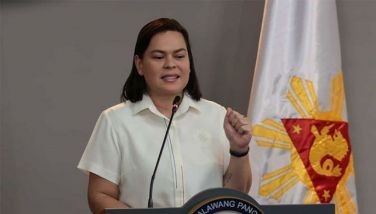Climate change and 2013
Two years ago, I bought an autobiography of Mahatma Gandhi. I thought that reading about his beliefs would inspire me to live simply and more peacefully and to be detached from material things. I look at the objects that surround me at home and know that I have a very long way to go before I can reach that goal.
I thought of my wish to live a more Earth-friendly and sustainable lifestyle as I listened to participants at a round table discussion on gender and climate change. Our resource persons all said that climate change is a result of human activity but some of them made an extra effort to describe what kind of human activity caused it. The burning of fossil fuels since the Industrial Revolution contributed to global warming that led to climate change and the weird weather that we are now experiencing.
The Philippines never had an Industrial Revolution. Thus, compared to industrialized countries like the United States, Japan and other countries in Europe, our greenhouse gas emissions are negligible. Because of this, calls by environmental activists for climate justice include a demand for the emitting countries to pay for the damage they have caused to the planet, specially the countries bearing the brunt of the effects of climate change, like our country.
One of the presenters described how cases of dengue fever have been rising through the years. It is possible that this was brought about by climate change and its effect on mosquitoes. Another presenter pointed out the effects of climate-related disasters on survivors, who have to deal not only with the loss of their homes but also with depression, the difficult conditions in an evacuation center, and threats from infection from illnesses that stem from the lack of clean water. Not surprisingly, women and children are most vulnerable.
While the temperatures are rising and everything is still dry, I hope that local government units (LGUs) are getting ready for the wet season and the challenges that we know for certain it will bring. With the Philippines always in the list of most disaster-prone countries, it would seem as if we would know the drill for any conceivable disaster and be stoic and prepared. Sadly, it hasn’t been the case, After Ondoy, for example, there was a mad scramble for LGUs to buy rubber boats. An urban rescue group would later point out that these boats were vulnerable to being punctured when used in a city setting. When Bulacan was flooded last year, makeshift wooden boats were more helpful in rescuing people trapped by floods.
There is a need to identify danger zones and to convince communities living there to move to a safer place. I saw a poster with drawings of generic dangerous places to avoid and I ended up even more confused after I read its contents. LGUs should review their terrains and make everyone understand the contents of geo-hazard maps. More importantly, LGUs should figure out where to move these communities. As a schoolmate pointed out, moving is an option only for those who can afford it.
Warning systems should be in place and the meanings of these warnings should be explained clearly to the public. This will prevent the panic and pandemonium similar to the one caused by the tsunami warning after the February 6, 2012 earthquake in Cebu.
This is the kind of planet we live in now. We have no choice but to adapt and mitigate the effects of climate change. We can exert personal effort to be more Earth-friendly but we also need to do our job as Filipino citizens to pressure government to be prepared for climate change. Local elections will be coming soon. Pay attention to our politicians. Vote only for those who understand what climate change means and are brave enough to make the tough decisions it calls for. Self-serving claims to love nature and trees and cute animals are not enough. Check what they are doing to show it.
* * *
Email: [email protected]
- Latest
- Trending




























